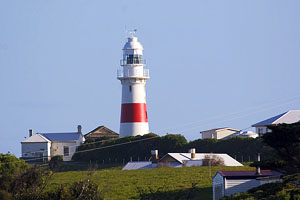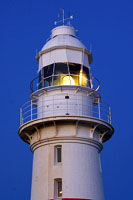
The first lighthouse at Low Head was first exhibited on 27 December 1833. Designed by Colonial Architect John Lee Archer,
it was Australia's 3rd lighthouse and Tasmania's 2nd. It was built by Huckson and Hutchison of Hobart and was first known as
the George Town Station. The station is situated
7km North of Georgetown and 50 km from Launceston on the East side of the Tamar River.
The keepers quarters were designed by William Moriarty and consisted of four rooms each. The quarters were attached to
either side of the tower, the only lighthouse in Tasmania with attached quarters. The structure, 15.25 metres (50 feet)
from the base to the top of the lantern, was erected by Mr Walmsley of Launceston.
The lantern was constructed at the Launceston Timber Yard, and the original lamps and reflectors were manufactured by
Mr William Hart. He supplied "six dozen lamps, including reflectors, at three shillings and sixpence each", and burned sperm whale oil.
In 1835 a revolving shutter, rotated by a clockwork mechanism was installed and in 1838 the original reflectors and Argand
lamps were replaced by a catoptric system sourced from Wilkins and Co of London
The tower was falling into disrepair, and it was necessary to rebuid it in 1888. The original convict-built stone tower
was pulled down and replaced with the present double brick structure, and painted white. The new tower utilised the original
revolving catoptric apparatus. Brewis, in his report of 1912, recommended a dioptic 3rd Order lens with 55mm incandescent mantle,
burning kerosene. The new lens supplied by Chance Bros. cost of £1,348 13s ld was installed in 1916.
An auxiliary light was added in 1898. This was a two-wick lamp from Chance Brothers, which showed a red warning light over
Hebe Reef from a window about 20 feet below the main light. The reef is named after the ship Hebe sailing from Madras, with
Indian goods for Port Jackson. Since that time 9 other vessels have been lost on the reef. The last was the BHP chartered Iron
Baron on 10 July 1995, nearing the end of a voyage from Groote Eylandt with a load of manganese ore. All crew were safely evacuated
and on July 16 it was refloated and moved offshore. Inspections confirmed major structural damage and it was towed to a site 85km
east of Flinders Island wehere it was sunk on 30 July.
|
|
In January 5 1926 a broad red band was painted around the middle of the tower to increase visibility during daylight hours.
A fog-horn operated by compressed air was installed in a shed near the tower in April 1929. It gave three blasts every minute in
the following pattern: a blast of 1.4 seconds followed by a 2.5-second silence; a blast of 1.3 seconds followed by another 2.5 second
silence; finally a 1.3-second blast followed by a silence of 51 seconds. There were reports of its having been heard from a distance of
9.6 km at sea and 32 km on land. It was discontinued in August, 1973, but has since been restored and is operated on most Sundays. The
Fog-horn, a type "G" diaphone and the Gardner engine is said to be the only fully operational system left in the world. It was
manufactured by Chance Bros. Birmingham.
In addition to the fog horn, the keepers were also responsible for the monitoring of the Tamar Leading Lights which had been
initially manned.
Low Head was also a rear leading light with a small light at Dotterell Point, for vessels departing Pt Dalrymple
On April 12, 1937, (some references indicate 1941) hydro-electric power was switched on at the station and the kerosene burner
was replaced by a 500 watt electric globe. The clockwork mechanism was also replaced by an electric motor. Candle-power increased
to 350,000. Just prior to 1950, the light was converted to mains power, and was de-manned.
From 1865 to 1912, the light was under the control of Alfred C. Rockwell and his son Alfred Rockwell Jnr, a period of 47 years!

Lighthouse Keepers Holiday Accommodation
Enquiries: Low Head Pilot Station 03 6382 2826
|